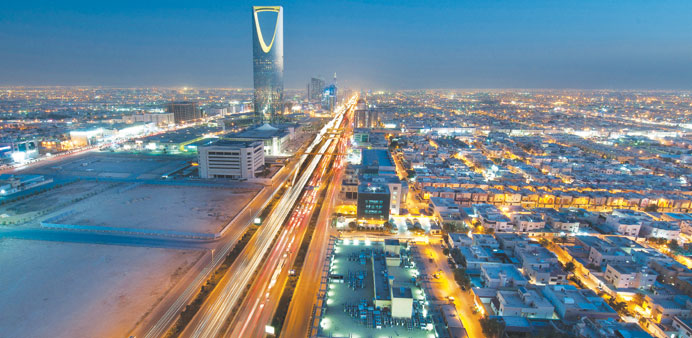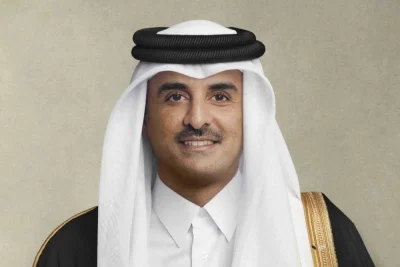The Kingdom Tower stands illuminated at night on King Fahad Road in Riyadh (file). The International Monetary Fund told Saudi Arabia this year it was spending more than it should if it wanted to preserve oil wealth for future generations, and that its state budget could fall into deficit by 2016 if expenditure continued rising fast.
Slowest rate of planned spending growth in a decade; follows big increases in wake of Arab Spring; IMF had warned budget was heading for deficit by 2016; another big budget surplus looks likely next year; puts more emphasis on private sector growth
Reuters
Riyadh
Saudi Arabia’s 2014 state budget projects spending will rise a modest 4.3% from this year’s plan, the slowest rate in a decade, suggesting the kingdom is starting to curb expenditure after years of huge increases.
Spending and revenue are both projected to total 855bn riyals ($228bn) next year, according to the plan announced by the Finance Ministry yesterday. That compares with expenditure of 820bn riyals and revenue of 829bn riyals in the original budget for 2013.
“I think they are demonstrating that there is discipline and commitment to a sustainable fiscal expansion,” said John Sfakianakis, chief investment strategist at MASIC, a Saudi investment company.
“Both budgeted spending next year and actual spending this year have a smaller increase than in previous years. Although they are still overspending, they’re overspending by less.”
Actual expenditure and revenue in the world’s top oil exporter often turn out to be much larger than its projections, with the kingdom posting big budget surpluses, as oil prices generally come in higher than its conservative assumptions.
Nevertheless, the 2014 budget suggests Riyadh has decided to rein in fiscal policy.
“The Saudi government has been spending generously to deal with the financial crisis, unemployment and housing problems. Now there is a need to press on the brakes,” said Saudi economist Abdulwahab Abu Dahesh.
Next year’s 4.3% rise in planned spending is far smaller than the 19% leap envisaged by the 2013 budget plan, and the lowest increase since 3.5% in 2003, Reuters calculations showed.
The International Monetary Fund told Saudi Arabia this year it was spending more than it should if it wanted to preserve oil wealth for future generations, and that its state budget could fall into deficit by 2016 if expenditure continued rising fast.
Lower state spending growth could now slow the economy. The Finance Ministry predicted on Monday that gross domestic product would rise only 3.8% this year, down from 5.8% in 2012.
The ministry did not specify the oil price which it is assuming in next year’s budget calculations, but investment bank EFG-Hermes estimated the plan assumes an oil price of $65-$68 a barrel and average output of 9.6mn bpd.
Brent crude oil is now trading at $111, suggesting the Saudi budget may again be comfortably in surplus next year. In 2013, the government is set to post a whopping surplus of 206bn riyals - equivalent to 7.4% of GDP - as actual spending exceeds the original budget plan by 13% but revenues come in 36% above target, the ministry said.
Between 2003 and 2012, state expenditure soared 14% on average every year, while budget plans were overspent by an average of almost 25%, Reuters calculations show.
The ministry’s 2014 budget shows authorities will continue to spend heavily on social welfare projects. It includes funds to build 465 schools and 11 hospitals, a 3% rise in education spending to 210bn riyals, and a 25% jump in spending on infrastructure, including new roads and railways as well as upgrades of ports and airports.
After big public sector wage increases in recent years, the budget figures suggest a fall in current spending - recurring expenditure such as salaries and consumable goods - by around 1.5%, said Monica Malik, chief economist for equity research at EFG Hermes Emirates.
“This budget puts more emphasis on the private sector for job creation and investment. It is making a statement that it’s for the private sector to take the lead,” she said.
Saudi Arabia remains vulnerable to any sharp fall of oil prices, but even in that case it would probably have room if needed to stimulate the economy with additional state spending. Public debt totals only 2.7% of GDP, the Finance Ministry said, while the central bank’s net foreign assets are worth almost three years of budget spending.



